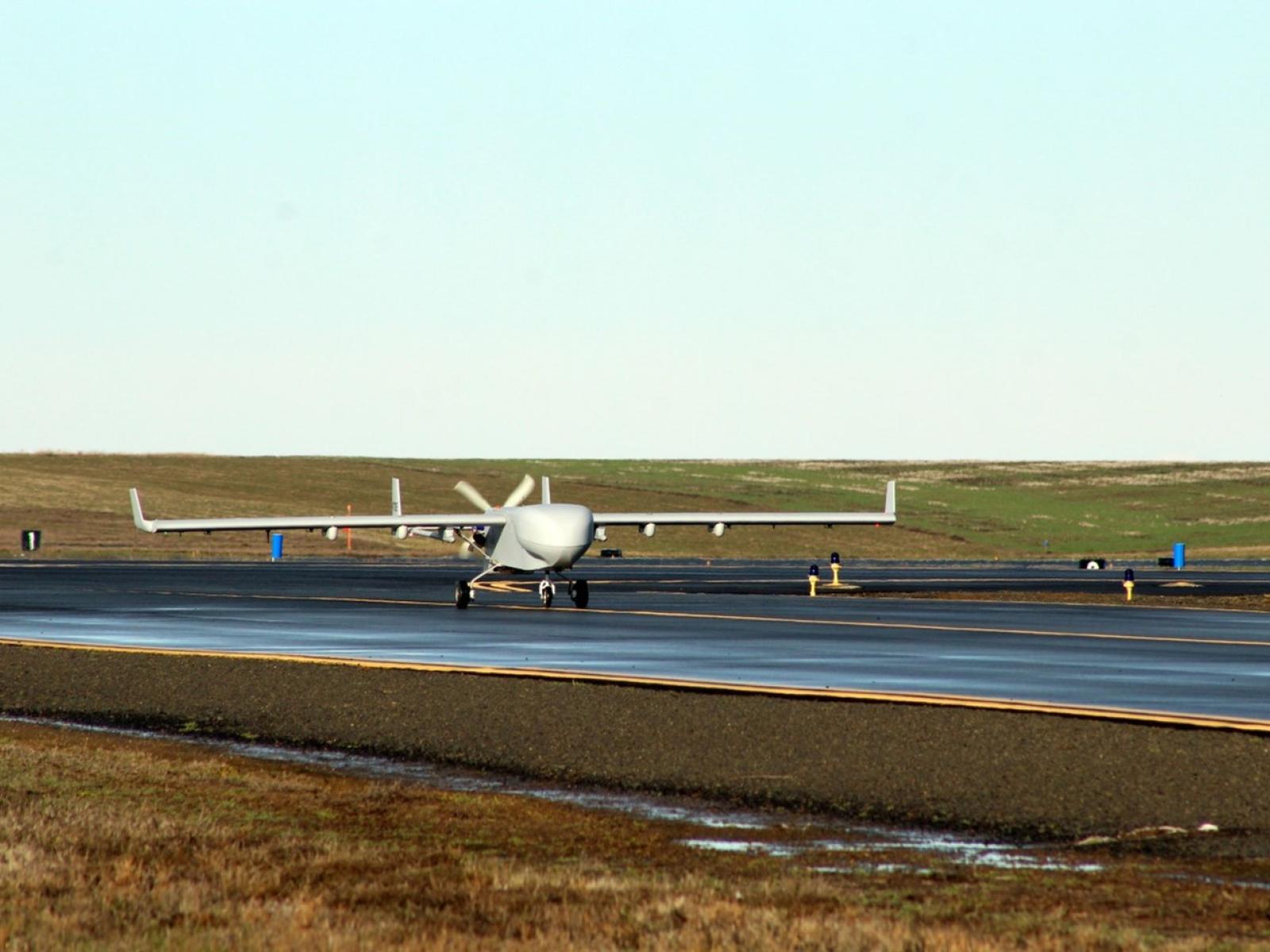Scratching the Surface of Aerosols with Uncrewed Aerial Systems
New method helps realize the potential of uncrewed aerial systems

Uncrewed aerial systems can help atmospheric scientists efficiently collect a wide range of samples and data.
(Photo: U.S. Department of Energy Atmospheric Radiation Measurement [ARM]) user facility)
Developing a picture of the atmosphere requires measurements from the ground and in the air. The advent of uncrewed aerial systems (UAS) has allowed researchers to develop new platforms for collecting data while in the air. One particularly important quantity to measure are aerosols.
Aerosols are tiny particles in the atmosphere that affect clouds, alter the balance of energy hitting and leaving Earth, and change the weather and climate. Representing their behavior remains a major uncertainty in current Earth system models. Aerosol data collection has been a common part of atmospheric measurement for decades, but new techniques are allowing researchers to sample and better understand the realities of aerosols.
Work led by Pacific Northwest National Laboratory (PNNL) atmospheric scientist Fan Mei and published in Bulletin of the American Meteorological Society, combines UAS measurements with state-of-the-art surface analysis techniques such as time-of-flight secondary ion mass spectrometry (ToF-SIMS) at the Environmental Molecular Sciences Laboratory (EMSL), a user facility supported by Department of Energy's (DOE’s) Biological and Environmental Research program, to create a more accurate description of three-dimensional (3-D) structure of aerosol particles. The team used aerosol data from several field campaigns conducted by the DOE Atmospheric Radiation Measurement (ARM) user facility. The data were collected over ARM’s Southern Great Plains atmospheric observatory in Oklahoma using UAS and ground-based measurements to guide model simulations.
Mei and her colleagues previously published a paper in Earth System Science Data describing the UAS datasets used in the new work. This is important foundational work as UAS data are becoming increasingly more common in atmospheric sciences.
“People talk about UAS measurements and how they can advance atmospheric research, especially the development and improvement of Earth system models (ModEx)” said Mei, who also oversees science efforts for the ARM Aerial Facility. “However, there are still a lot of foundational gaps we need to fill. This work is a step in making the potential of UAS a reality.”
Studying the surface of aerosol particles
Mei took inspiration from materials science for this work. “I was talking to researchers across PNNL about the challenges of this project,” said Mei. “I discussed difficulties characterizing aerosols with experimentalists and how to use data to bridge the gap between the model simulation and the observation with modelers. I found that materials science already used the type of surface-sensitive technique we needed. We just had to adapt it to work with our samples, which is easier said than done.”
After extensive testing and optimization, the team collected aerosol samples from the Southern Great Plains observatory and characterized their surface structure at EMSL, which houses a collection of state-of-the-art surface analysis instruments. The results were surprising. Previous data that studied entire particles reported similar aerosol composition which were either half carbon-based, or organic, and half non-carbon-based, or inorganic. This led to model projections that consistently overestimated the presence of clouds, which form on aerosol particles.
The surface measurements told a different story. While the aerosols were half organic and half inorganic on average, their surfaces were effectively 100 percent organic. This means all the particles interact with the atmosphere as if they were purely organic aerosol.
“These surface measurements initially amazed me,” said Hailong Wang, an atmospheric scientist at PNNL and co-author of the study. “The Earth system and cloud models I work with generally assume that the organic and inorganic aerosol components are mixed. We adjusted how our cloud model treats aerosol particles to reflect the realities of the aerosol surfaces. Combined with UAS data on particle size and number, our models show clouds that have fewer droplets and are less bright. These results are more accurate and better match the ARM remote sensing data.”
This current work serves as a proof of concept for how the multidisciplinary techniques available at DOE user facilities can help atmospheric scientists and better link observation capabilities with modeling needs. The richer data can lead to more accurate models, by filling in gaps through combined UAS measurements and advanced laboratory techniques. This can lead to a more holistic understanding of atmospheric processes.
“We need to collect more data that covers more space to provide observational constraints for aerosols in global models, such as the Department of Energy’s Energy Exascale Earth System Model,” said Wang.
“I think the future of UAS measurements is bright,” said Mei. “As these measurements become more common, including on future ARM campaigns, it’s important to know what unique insights we can gain from them that are useful to improve global aerosol-cloud modeling and climate projection.”
This work was supported by the DOE ARM, and the Atmospheric System Research program, while ToF-SIMS measurement was performed at EMSL. In addition to Mei and Wang, PNNL authors on the Bulletin of the American Meteorological Society paper include Zihua Zhu, Damao Zhang, Jerome Fast, William Gustafson, Xiangyu Li, Beat Schmid, and Jason Tomlinson. Authors also include Qi Zhang and Christopher Niedek of the University of California, Davis and Connor Flynn of the University of Oklahoma.
In addition to Mei, Fast, Schmid, and Tomlinson, PNNL authors on the Earth System Science Data paper are Mikhail Pekour, Lexie Goldberger, and Rob Newsom. Other co-authors include Darielle Dexheimer and RaeAnn Cook of Sandia National Laboratories and Gijs de Boer of the University of Colorado, Boulder and the National Oceanic and Atmospheric Administration.
Published: April 15, 2024